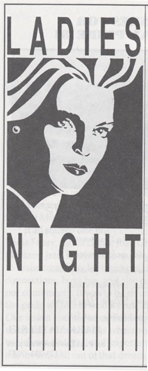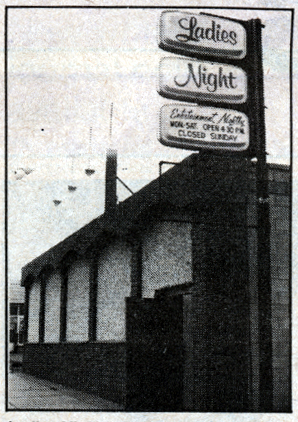Difference between revisions of "Ladies Night"
m (Protected "Ladies Night" [edit=sysop:move=sysop]) |
|||
| (3 intermediate revisions by one other user not shown) | |||
| Line 1: | Line 1: | ||
<div style="text-align: center;"> | <div style="text-align: center;"> | ||
| − | '''1183 University Avenue, St. Paul, MN''' | + | '''1183 University Avenue, St. Paul, MN (1985-1991)''' |
</div> | </div> | ||
| Line 26: | Line 26: | ||
The lesbian bar was not the first in Muph’s business repertoire—she and Eleanor "Honey" Harold previously operated the Castle Royale in the Wabasha Street Caves on the West Side Flats. Unfortunately, the space was too large and the Castle Royal closed within a few years of opening—at least, that’s what [[Equal Time]] reported. | The lesbian bar was not the first in Muph’s business repertoire—she and Eleanor "Honey" Harold previously operated the Castle Royale in the Wabasha Street Caves on the West Side Flats. Unfortunately, the space was too large and the Castle Royal closed within a few years of opening—at least, that’s what [[Equal Time]] reported. | ||
|} | |} | ||
| − | |||
| Line 34: | Line 33: | ||
|- | |- | ||
| | | | ||
| − | A significant contribution to the Castle Royal’s demise resulted from the longstanding boycott of Coors Beer. The boycott, begun in 1973 by labor unions, quickly gained the support of gay men and lesbian women when information surfaced about the company’s severely discriminatory hiring practices. Prospective Coors employees were put through a polygraph test, and the questionnaire included invasive quandaries about the prospect’s sexual orientation.(3) Lasting for decades, the boycott symbolized the might of GLBT consumers; community members equated drinking Coors Beer with committing treason. | + | A significant contribution to the Castle Royal’s demise resulted from the longstanding boycott of Coors Beer. The boycott, begun in 1973 by labor unions, quickly gained the support of gay men and lesbian women when information surfaced about the company’s severely discriminatory hiring practices. |
| + | |||
| + | |||
| + | Prospective Coors employees were put through a polygraph test, and the questionnaire included invasive quandaries about the prospect’s sexual orientation.(3) Lasting for decades, the boycott symbolized the might of GLBT consumers; community members equated drinking Coors Beer with committing treason. | ||
Latest revision as of 11:22, 1 May 2010
1183 University Avenue, St. Paul, MN (1985-1991)
| Ladies Night Ad from the 1986 Twin Cities Pride Guide. Courtesy of the Jean-Nickolaus Tretter Collection. |
Darlene "Murph" Murphy opened Ladies Night on University Avenue in 1985.(1) Formerly a strip club for the straight men’s entertainment, the windowless structure was part of an X-rated district that centered on the Faust Theater at Dale and University.
|
|
A significant contribution to the Castle Royal’s demise resulted from the longstanding boycott of Coors Beer. The boycott, begun in 1973 by labor unions, quickly gained the support of gay men and lesbian women when information surfaced about the company’s severely discriminatory hiring practices.
This atmosphere of extreme loyalty to GLBT-friendly products even produced occasional boycotts of queer businesses. Such was the case shortly before “the Royale” closed; patrons caught Honey selling Coors under the counter, and a boycott of the bar ensued.(4) In part, the boycott sealed Castle Royal’s fate.
|
Exterior of Ladies Night in 1985, immediately after the bar changed from a strip club to a lesbian bar. From Equal Time News, Courtesy of the Jean-Nickolaus Tretter Collection. |
(1)Douma, Gretchen. "News Bars Expand St. Paul Nightlife." Equal Time, Issue 90, 9/18/1985. Page 5.
(2) Ibid.
(3) Rapp, Linda. "Boycotts" featured on www.glbtq.com, page 2. Retrieved 3/24/2010. http://www.glbtq.com/social-sciences/boycotts,2.html
(4) Tretter, Jean-Nickolaus. Interview with the author, 3/24/
(5) By 1992, the site had transformed into the Metro Bar. "St. Paul / Police release two men, woman arrested after slaying at University Av. bar," The St. Paul Pioneer Press, 12/3/1992.
Part of Minneapolis/St. Paul, MN: 100 Queer Places in Minnesota History, (1860-1969), (1969-2010)

